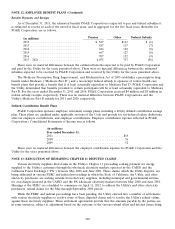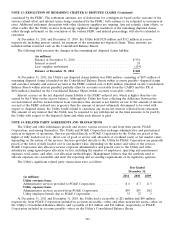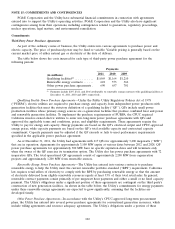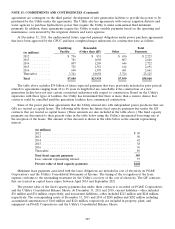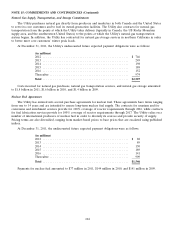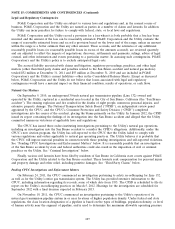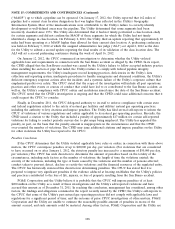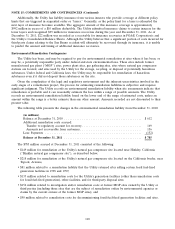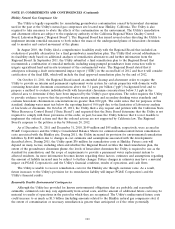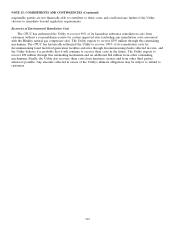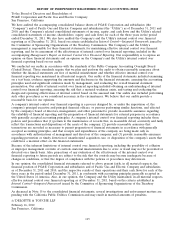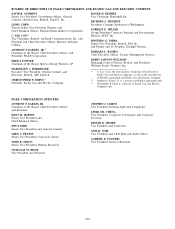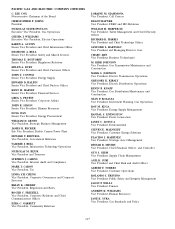PG&E 2011 Annual Report Download - page 112
Download and view the complete annual report
Please find page 112 of the 2011 PG&E annual report below. You can navigate through the pages in the report by either clicking on the pages listed below, or by using the keyword search tool below to find specific information within the annual report.NOTE 15: COMMITMENTS AND CONTINGENCIES (Continued)
(‘‘MAOP’’) up to which a pipeline can be operated. On January 17, 2012, the Utility reported that 162 miles of
pipeline had a current class location designation that was higher than reflected in the Utility’s Geographic
Information System. Most of the misclassifications were attributable to the Utility’s failure to correctly identify
development or well-defined areas near the pipeline. The Utility determined that some segments had been
incorrectly classified since 1971. The Utility also determined that it had not timely performed a class location study
for certain segments and did not confirm the MAOP of those segments for which the Utility had not timely
identified a change in class location. On February 2, 2012, the Utility filed an update reporting that approximately 10
miles had been operating at a MAOP higher than allowed for their current class location. A prehearing conference
was held on February 3, 2012 at which the assigned administrative law judge (‘‘ALJ’’) set April 2, 2012 as the date
for the Utility to submit a second update reporting the final results of its validation of the class location data. The
ALJ will set a second prehearing conference during the week of April 16, 2012.
On January 12, 2012, the CPUC commenced an investigation to determine whether the Utility violated
applicable laws and requirements in connection with the San Bruno accident as alleged by the CPSD. In its report,
the CPSD alleged that the San Bruno accident was caused by the Utility’s failure to follow accepted industry practice
when installing the section of pipe that failed, the Utility’s failure to comply with federal pipeline integrity
management requirements, the Utility’s inadequate record keeping practices, deficiencies in the Utility’s data
collection and reporting system, inadequate procedures to handle emergencies and abnormal conditions, the Utility’s
deficient emergency response actions after the incident, and a systemic failure of the Utility’s corporate culture that
emphasized profits over safety. The CPUC stated that the scope of the investigation will include all past operations,
practices and other events or courses of conduct that could have led to or contributed to the San Bruno accident, as
well as, the Utility’s compliance with CPUC orders and resolutions issued since the date of the San Bruno accident.
The CPUC noted that the CPSD’s investigation is ongoing and that the CPSD could raise additional concerns that it
could request the CPUC to consider.
Finally, in December 2011, the CPUC delegated authority to its staff to enforce compliance with certain state
and federal regulations related to the safety of natural gas facilities and utilities’ natural gas operating practices,
including the authority to levy citations and impose penalties. The Utility has filed several self-reports to inform the
CPUC of violations of various regulations and orders applicable to its natural gas operating practices. Recently, the
CPSD issued a citation to the Utility that included a penalty of approximately $17 million for certain self-reported
violations for failing to conduct periodic surveys due to plat maps being misplaced. The Utility has appealed the
penalty, in part, on the basis that the penalty amount is inappropriate in the circumstances and that the CPSD
over-counted the number of violations. The CPSD may issue additional citations and impose penalties on the Utility
for other violations the Utility has reported to the CPUC.
Penalties Conclusion
If the CPUC determines that the Utility violated applicable laws, rules or orders, in connection with these above
matters, the CPUC can impose penalties of up to $20,000 per day, per violation. (For violations that are considered
to have occurred on or after January 1, 2012, the statutory penalty has increased to a maximum of $50,000 per day,
per violation.) The CPUC has wide discretion to determine the amount of penalties based on the totality of the
circumstances, including such factors as the number of violations; the length of time the violations existed; the
severity of the violations, including the type of harm caused by the violations and the number of persons affected;
conduct taken to prevent, detect, disclose or rectify the violations; and the financial resources of the regulated entity.
The CPUC has historically exercised this discretion in determining penalties. The CPUC has stated that it is
prepared to impose very significant penalties if the evidence adduced at hearing establishes that the Utility’s policies
and practices contributed to the loss of life, injuries, or loss of property resulting from the San Bruno accident.
PG&E Corporation and the Utility believe it is probable that the CPUC will impose penalties of at least
$200 million on the Utility as a result of these investigations and the Utility’s self-reported violations and have
accrued this amount as of December 31, 2011. In reaching this conclusion, management has considered, among other
factors, the findings and allegations contained in the report recently issued by the CPSD; the Utility’s self-reports to
the CPUC that some of the Utility’s past natural gas operating practices did not comply with applicable laws and
regulations for a significant period of time; and the outcome of prior CPUC investigations of other matters. PG&E
Corporation and the Utility are unable to estimate the reasonably possible amount of penalties in excess of the
amount accrued, and such amounts could be material. Among other factors, PG&E Corporation and the Utility are
108




